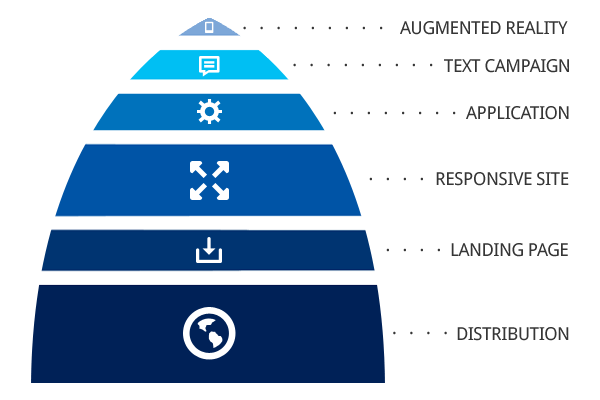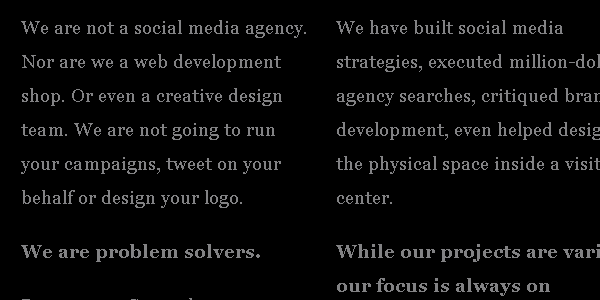The post How Should I Start My Mobile Strategy? appeared first on Travel 2.0 Consulting Group.
]]>Some have an app, others a mobile website. Text campaigns, AR, landing pages, where and how should you start your tourism organization’s mobile strategy?
As part of my keynote presentation at the Hoosier Hospitality Conference, I created the Mobile Strategy Decision-Making Pyramid…or, MSDMP for short…to definitively answer the question, where do I start my tourism organization’s mobile strategy?

Reading the Pyramid
The layers or levels in the pyramid should be implemented from bottom to top, building from the basics to some advanced and very specific marketing / communication techniques.
The bands of color are proportionate to the amount of resources you should spend at each level. More on Responsive Design, less on a Texting Campaign.
Level 1: Distribution

The first step in your mobile strategy should be to audit and if needed, improve, the distribution of your organizations information.
Where does information about your hotel, restaurant or attraction live in terms of mobile?
How is it discovered?
Is it accurate?
Start with the big directories of local content first: and .
After the whole Apple Maps snafu, the new Google Maps App for iOS (iPhone), was downloaded 10 million times in a 48 hour period. Without question, Google Maps is one of the most popular, downloaded and utilized apps on any mobile device. Make sure your information can be found and is correct.
Next, move to the major social and geosocial networks.
Use for a quick (and free) search of your current presence. Or, sign-up with a company like for a more robust local marketing monitoring solution.
Put in the required and repeated effort at this level to ensure that your content is available, correct and useful.
Level 2: Landing Page

Organizations will either skip this level, temporarily wait at this level (for a web development update project) or stop at this level, but you should understand why a mobile landing page is important for your mobile strategy.
Now that you have built a solid foundation of distribution for your information, people will be clicking from Google Maps to your website.
And you need to ensure, at a minimum, that the first interaction with your website is a good one.
Set up a mobile redirect based upon screen size, () and direct users to a friendly, mobile-specific landing page.
The goal of this landing page? Delivering critical, decision-making content quickly and in an easy-to-read and -use format.
For example, if you are a restaurant, content such as directions, address, phone number, reservation policy, dress code and perhaps daily specials.
Quick, informative and enough information to convince me to choose your restaurant.
For helping building a mobile landing page, you can call your web developer or utilize .
Ah, feeling more mobile already, right?
Level 3: Responsive Site

If you are building a mobile presence, you should be building a responsive mobile site. Period.
Not mobile friendly, not mobile adaptive and not any of the other agency bullshit buzzwords.

Responsive.
But, don’t get confused or distracted by the technology, a responsive solution is not about making things smaller based upon screen size. It is about making content smarter based upon screen size.
A good responsive mobile site should contain all of the content on your full-size site, but thoughtfully arranged, ordered and presented in a format useful to the consumer.
And a responsive strategy should mean a rethink of your content from a mobile-first approach, not a desktop-first approach.
When you rebuild or update your current digital content to include a responsive design, don’t start by bringing everything over from the old site.
Start with a clean slate.
And start with a mobile / responsive focus.
Advanced Mobile Strategy
Up until this point, the previous levels represent a nearly universal mobile strategy. But the next three levels required a specific use case, consumer need and business goal to be successful.
Executing any of these levels simply because a competitor is doing it, or it looks cool, is a waste of your mobile strategy.
Level 4: Mobile Application

The majority of DMOs, CVBs, hotels, restaurants, attractions, museums, water parks, graveyards, Space Needles and other tourism-related businesses do not need a mobile application.
iPhone, iPad or Android.
You simply don’t need one.
Why? Because the majority of the mobile goals you need to accomplish can be completed effectively with a mobile website.
Only organizations with a specific consumer need or specific use case should build a mobile app.
For example, the banking app on your phone likely contains a deposit by phone feature…where you snap a picture of your check and deposit it via the magic of the internet…a feature that would have been complex and costly, if not impossible, if built as a mobile website.
Strong consumer need, strong use case.
If you are considering a mobile application, ensure that you have a strong consumer need, a clear use case scenario and defined goals.
Level 5: Text Campaign

The statistics are tantalizing. But the execution of a text or SMS marketing campaign is complex and difficult.
Why? Because consumers view texting from a different perspective than mobile applications or email. It is a personal communication tool. Heavily guarded against spam. And for many younger Americans, their preferred method of communication.
Again, it is tantalizing, but the statistics are clear: (.PDF).
While there are certain use cases where a SMS campaign would be a solid strategy, those are few and far between. Which is why text campaigns sit at the top of the pyramid.
Few of our peers should attempt them, and their overall place in your mobile strategy should be small in proportion to a responsive site and mobile distribution.
Level 6: Augmented Reality

Augmented Reality or AR is a fascinating example of technology merging with the real world. Previously highlighted via mobile, now being carried by the development of .
But for 99% of you, our peers, potential readers, AR is not a topic that should appear in your mobile strategic plan.
The technology is simply too young, with too much ongoing development, for you to consider at this point.
In fact, the few examples of AR technology currently in the marketplace commonly utilize directory content to populate the experience.
The same directory content you should be populating and managing at level 1.
Your Mobile Strategy
While your mobile strategy may contain different elements or tactics, we are confident that the majority of tourism organizations…DMOs, attractions or hotels…should follow the structure and approach of the mobile strategy pyramid.
6 clear levels to build a solid mobile strategy.
The post How Should I Start My Mobile Strategy? appeared first on Travel 2.0 Consulting Group.
]]>The post Why Blogging was the Best Business Decision I Ever Made appeared first on Travel 2.0 Consulting Group.
]]>During a recent conversation with an aspiring tourism professional, I realized how important my writing has been to the growth of my consulting career and in turn, the success of the Travel 2.0 Consulting Group.
That is not to say I under appreciated the value of writing prior to the conversation, but I had not considered how difficult the move to consulting would have been without the experience garnered through writing.
As we discussed the tourism industry, I kept returning to the importance of writing as the cornerstone of my career path.
And how could I not share those thoughts with our readers?
From Blogging to Writing
When I started the Travel 2.0 blog nearly 6 years ago, it truly was a blog. Short comments and observations about tourism topics and larger articles. It was a derivative work. Like so many other blogs, adapted from the work of others.
As you can see in the original post, Email Experts on the new Outlook, the content was meant for an internal audience, which at the time, was my team at the Arizona Office of Tourism.
But over the past 6 years, the content, tone and writing style of the blog has changed. More articles than blog posts and less blog than focused journal.
Original, in-depth and driven by our own expertise.
See Why Focusing Your Content Strategy is Critical for Success.
So, I hesitate to call it a blog.
Writing Kept Me On Task
Quitting your job and deciding to run your our firm, freelance career or cupcake bakery can be a dramatic shock to the system. No more boss, no more due dates, no more meetings. It is an overwhelming sense of freedom that can be as rewarding as it is debilitating.
Many peers have asked the same question: How did you stay focused?
The answer, for me, was writing. While I was fortunate enough to get into a regular routine while at two, paycheck-providing jobs, the demands of writing kept me on task when I moved into the consulting role.
There was both an internal pressure to keep writing…personally, I wanted to share my thoughts…and an external pressure created and delivered by our readers.
When I disappear for more than 2 weeks, usually due to client work, the emails begin to increase.
Are you okay?
Are you on vacation?
Don’t tell me you stopped!
Without the demands and routine created by writing, I don’t think I would have made the transition from corporate to freelance so easily.
Experts Write
It’s as simple as that. Experts write.
If you want people to listen to what you have to say, you have to say something.
Expert labels aside…and goodness knows too many people self-assign that title…it is important to share your thoughts, gather feedback and grow your perspective.
Do be afraid to write. I have written some great articles and some shit articles. My opinion has changed over time. But having that record, good or bad, is what informs and shapes your growth moving forward.
No one will anoint you as an expert during your first day on the job. Nor will anyone call you an expert without knowing your opinion.
Write to develop, grow and share your expertise.
Head Start
There is no doubt, that this blog, my writing, the constant beat of the ‘this is what I think’ drum was (and still is) instrumental to the success I have experienced with the on-demand tourism consulting practice.
Writing has introduced me to so many people that I would have otherwise never interacted with.
It is both satisfying and shocking, to hear a total stranger say ‘I know you, I read your articles.’
Humbling + Honest
There is nothing more humbling than writing.
For all the inflated self-worth gathered from a single clever tweet or a high Klout score, a blog is a sharp realization that in fact you do not know everything.
I have said it often, the comments and commenters on Travel 2.0 make the conversation, and in-turn my writing, so much better.
Without readers keeping you honest and comments keeping you humble, your writing will quickly morph into equivalent of a sixteen-year-old’s dream diary.
Write + Share
Whether you are promoting yourself, your destination or your cupcake bakery, I would strongly encourage you to write.
Share your thoughts.
Try our new ideas.
Talk with other peers.
Ask questions.
Stay humble.
It might just be the best business decision you ever make.
The post Why Blogging was the Best Business Decision I Ever Made appeared first on Travel 2.0 Consulting Group.
]]>The post Why (and How) I am Renting Out My Brain appeared first on Travel 2.0 Consulting Group.
]]>Well worth the next 5 minutes of your time.
Walk the Walk
Our discussion of travel-enticing content centered around the idea of focusing your content and answering useful questions. It also touched upon the need for simplicity, a subject we have also written about.
But as I looked at our own pages, I felt the need to reevaluate our content and content marketing efforts. Specifically, the Consulting page began to bug the shit out of me.

Blah, blah, blah.
Too much text.
Too much focus on answering the wrong questions.
Of course, many of our consulting peers suffer from the same affliction…attempting to explain the entire history, philosophy and rationale of their services without addressing the potential client’s key questions.
Or just trying too damn hard to be clever.
See for examples.
Conducting a Self-Audit
I have a pretty simple conversion path for Travel 2.0.
People typically find the site through an article. After reading the article we want them to complete one of two actions: 1. Learn more about our consulting services. Or 2. read another article (either directly or via our email subscription).
You can see this approach at work in the sidebar (scroll back up). 3 calls to action: Consulting, most-recent article or email sign-up.
Done.
While I am satisfied with the success of our additional reading goal based upon Google Analytics and our email sign-up rate, the consulting page did not answer the right questions to move the reader (you) closer to working with us.
Call it consultant-enticing content.
Specifically, two questions rose to the top of the list: How can Travel 2.0 help us? How much does it cost?
The helping question meant destroying and simplifying some lovely, but thesaurus-riddled existing copy. Not a big loss.
But the cost question represents a perceived taboo in consulting, revealing your pricing model is rarely done, especially in the public domain of a website.
Yet the consumer wants to know the answer to that question.
So, I needed a way to simplify the page, provide the needed answers and somehow give people a price.
For Rent: My Brain
The answer is a combination of clear pricing, easy to understand deliverables and a simple price point.
I am renting out space in my brain, unlimited access, to a maximum of 10 clients, for $1,000 per month.
We are calling it On-Demand Tourism Consulting, but others such as Rohit Bhargava and Tom Martin call it and , respectively.
I really like this approach because it works, as evident by our current clients, plus it provides a clear answer to any prospective clients.
Here is how much I cost, no strings attached.
The pricing is clearly stated. Some might think the price is too low (or too high), but I don’t see it as a detriment to my value. I think the pricing is fair and appealing for potential clients.
And it is much better than making you guess.
Damn, I really like this model.
Transparent. Easy to understand. Even easier to explain. And it creates a sense of urgency and exclusivity.
That is why (and how) I am renting out my brain.
Simple, useful and focused.
Exactly what I have been saying.
The post Why (and How) I am Renting Out My Brain appeared first on Travel 2.0 Consulting Group.
]]>The post Why Focusing Your Content Strategy is Critical for Success appeared first on Travel 2.0 Consulting Group.
]]>I am paraphrasing Katie, but that is pretty close.
Unfortunately, Katie and I are too far apart to share a beer while discussing the finer points of content strategy, but I did want to conclude our stretch of travel-enticing content articles with a few final thoughts on why it is important to focus your content.
Common Content
There are too many travel and tourism content sources available to merely be average.
The barrier to creating a tourism destination website, mobile site or mobile app is extremely low. Basic content and information about a destination is plentiful and easy to replicate.
And not only from the major powers in the travel industry…OTAs, guide books, review sites…no, we are now seeing consumers with a slightly heightened interest in a specific city, region or country creating content and sucking up market share.
See visitboston.org. (No link, they don’t deserve it.)
Or .
And the brand efforts of .
There is certainly nothing wrong with competition. But you need to realize that there is competition, especially at the low-end of the content ladder.

A Trend to Help
The consumer, now overwhelmed with a plethora of content opportunities, Facebook like requests and demands to hashtag everything, is slowly becoming numb to average content.
Distributing easy-to-use and helpful content is path forward for many organizations.
Call it a trend but the formula is a simple one.
High-value, useful content > mass-produced, evergreen content.
No offense to the evergreens.
In fact, our peer
While I have not had the opportunity to read the entire book, the descriptions and thoughts Jay has provided in the run up to the launch of the book are pretty clear.
What if instead of trying to be amazing you just focused on being useful?
Your content actually needs to contribute, answer a question, help someone.
Not just lie there in an overgrown evergreen forest.
Inspirational Goals
The third factor in our theory of travel-enticing content is a need for measurement.
Our DMO client has plenty of content, but we needed to know, definitively, what content is working and what content is failing.
Particularly for destination marketing organizations, a focus on content is important considering the average digital consumer interacts with a DMO once.
Not 2 or 3 times.
Once.
The consumer is visiting a single page and determining in less than 10 seconds whether or not your content is helpful to them. If it is, your chances of moving that consumer closer to the moment of travel increase. If it is not, the consumer clicks the back button and looks elsewhere.
Therefore it is critical that the DMO or NTO knows exactly what the goal of each page is, but also how well it is converting.
The strong content stays, the weak content gets deleted.
Unfortunately too many DMOs simply add content and forget it. Unaware of what is working and what is failing.
Now and How
The idea of useful content or travel-enticing content should not be a new development. It should be the only type of content that every tourism organization develops and distributes.
Alas, as we have discussed, political motives and profitable eyeballs have got in the way.
But now we are seeing a shift toward clear and effective content.
To truly be successful in this new world of competition and Youtility, one must be able to measure the successfulness of their content marketing efforts and implement a strategy that truly delivers travel-enticing content.
Otherwise, your destination will just be one of the trees in a very thick evergreen forest.
The post Why Focusing Your Content Strategy is Critical for Success appeared first on Travel 2.0 Consulting Group.
]]>The post How We Move Clients Toward a Travel-Enticing Content Model appeared first on Travel 2.0 Consulting Group.
]]>However simply saying you want content that entices travel is not enough.
Nor is it enough to slap a ‘request a guide’ link at the end of every story, article or member page.
A focus on travel-enticing content is an internal commitment to understand and recognize the purpose and role of each piece of content from the perspective of the consumer’s needs.
Currently, digital thinking on content goes something like this:
We have 10,000 pages of content and because we have so many, I can’t possibly monitor each and every one…which is what we want.
Travel-enticing content forces a change to that perspective:
We have 400 pages of content and because we have such a focused selection of content, I have direct knowledge of the performance of each page.
A lot of content and knowing little, to a little content and knowing a lot.
To help explain the process, let’s take a look at our approach to content strategy.
Auditing and Focusing
Currently, we follow a direct, yet intensive, process to move toward a travel-enticing content model. It is a process that has been implemented and utilized by a number of firms and organizations, including the

Audit
Identifying and cataloging every piece of content as well as common search terms. For one client, this list topped out at nearly 2,500 unique items.
Needs
After we have the master list, we begin to collate like items into logical groups and assign a priority. Often, this includes identifying numerous instances of duplicate content and a realization from the client that they really have been confusing the shit out of their consumers.
Scope
At this point, we start trimming via a set of core questions to determine if the content groups truly provide a travel-enticing solution.
For example: Do consumers reasonably expect the DMO / CVB to provide this content?
One of two things will likely happen at this point: Either 1) you will cut the content or 2) you will vastly improve the piece of content to save it.
Organization
Now that we have a refined list of content needs, we re-organize the list into logical groups.
Prioritization
Then, we re-prioritize the categories based upon consumer need and organizational goals.
Content Plan
Finally, we are left with a clear list of categories, content and priorities that make up a content marketing action plan.
Beyond the Content Audit
For many agencies and consultants, the content strategy begins and ends with the audit.
Rearrange the crap into slightly less-confusing crap.
What is required for success is not a spreadsheet, but a thorough understanding of which pieces of content work and which do not. Then, the ability to kill crap content via a clear and vetted content marketing action plan.
Content marketing success is not having the most content, but rather content that clearly answers a consumer’s need.
Content that entices travel.
And the best way to discover and develop travel-enticing content is through one hell of a holistic content model.
Not just a big spreadsheet.
The post How We Move Clients Toward a Travel-Enticing Content Model appeared first on Travel 2.0 Consulting Group.
]]>